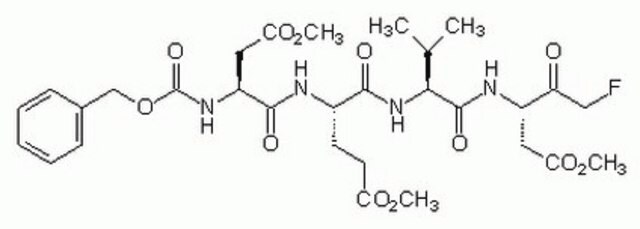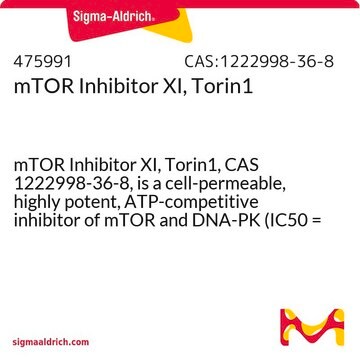Recommended Products
description
Bafilomycin A1 is a specific potent inhibitor of vacuolar-type H+-ATPases, and blocks lysosomal cholesterol transport in macrophages.
Quality Level
manufacturer/tradename
Upstate®
technique(s)
activity assay: suitable (kinase)
storage temp.
−20°C
Application
Bafilomycin A1 has been used:
- as an autophagy inhibitor to study its effect on traumatic brain injury (TBI)-induced cell death and lesions in mice
- to treat neurons for pH luorin assays to measure endocytosis during synaptic activity
- to block autophagy in mouse embryonic fibroblasts
Biochem/physiol Actions
Inhibitor Type: Kinase
Physical form
C35H58O9
Storage and Stability
3 years at -20°C
Legal Information
UPSTATE is a registered trademark of Merck KGaA, Darmstadt, Germany
Disclaimer
Unless otherwise stated in our catalog or other company documentation accompanying the product(s), our products are intended for research use only and are not to be used for any other purpose, which includes but is not limited to, unauthorized commercial uses, in vitro diagnostic uses, ex vivo or in vivo therapeutic uses or any type of consumption or application to humans or animals.
Storage Class Code
11 - Combustible Solids
WGK
WGK 3
Certificates of Analysis (COA)
Search for Certificates of Analysis (COA) by entering the products Lot/Batch Number. Lot and Batch Numbers can be found on a product’s label following the words ‘Lot’ or ‘Batch’.
Already Own This Product?
Find documentation for the products that you have recently purchased in the Document Library.
Customers Also Viewed
Wenchang Xiao et al.
Signal transduction and targeted therapy, 6(1), 152-152 (2021-04-17)
Autophagy is the main degradation pathway to eliminate long-lived and aggregated proteins, aged or malfunctioning organelles, which is essential for the intracellular homeostasis and prevention of malignant transformation. Although the processes of autophagosome biogenesis have been well illuminated, the mechanism
Seongju Lee et al.
International journal of molecular sciences, 21(21) (2020-11-01)
Keloid is a representative chronic fibroproliferative condition that occurs after tissue injury. Emerging evidence showed that activation of NACHT, LRR, and PYD domains-containing protein 3 (NLRP3) inflammasome is involved in the pro-inflammatory response in injured tissues. However, the role of
Jianzhong Li et al.
Frontiers in cell and developmental biology, 8, 576988-576988 (2020-12-15)
Bixin, a natural carotenoid extracted from the seeds of Bixa orellana, has antioxidant and anti-inflammation effects. However, the pharmacological effects and underlying mechanisms of bixin in kidney interstitial fibrosis remain unknown. Partial epithelial-to-mesenchymal transition (EMT) of tubular cells has been
Asli E Dogan et al.
The Journal of biological chemistry, 298(7), 102050-102050 (2022-05-23)
The double-stranded RNA-dependent protein kinase activating protein (PACT), an RNA-binding protein that is part of the RNA-induced silencing complex, plays a key role in miR-mediated translational repression. Previous studies showed that PACT regulates the expression of various miRs, selects the
Hang Yang et al.
Virologica Sinica, 37(3), 380-389 (2022-03-11)
The recent COVID-19 pandemic poses a global health emergency. Cellular entry of the causative agent SARS-CoV-2 is mediated by its spike protein interacting with cellular receptor-human angiotensin converting enzyme 2 (ACE2). Here, by using lentivirus based pseudotypes bearing spike protein
Our team of scientists has experience in all areas of research including Life Science, Material Science, Chemical Synthesis, Chromatography, Analytical and many others.
Contact Technical Service












